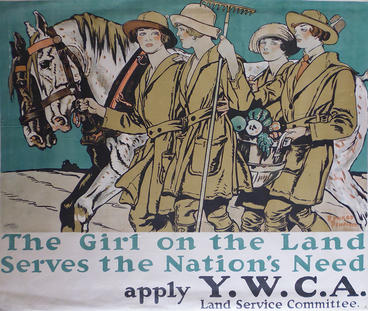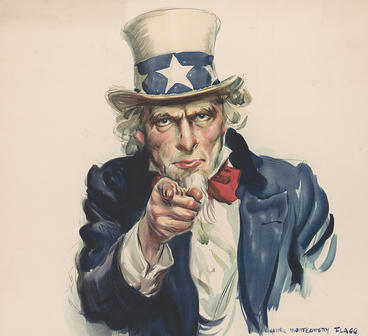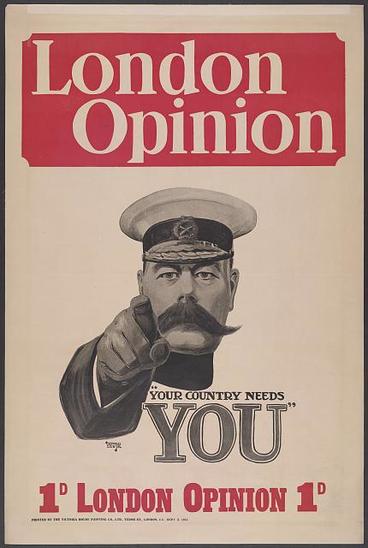
FEATURED ESSAY
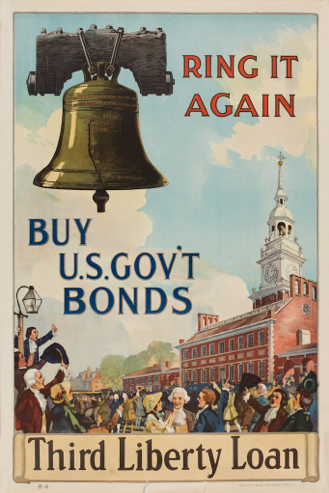
Many of the World War I posters included in the Fight or Buy Bonds exhibit address the challenges of mobilizing the American economy to meet the needs of the war and ask the public to accept the burdens. Even though American involvement in the war was much shorter than that of the European powers, the conflict made unprecedented demands on the economy. It was the first major war to be fought simultaneously on land, at sea, and in the air with mechanized weaponry. It saw the initial deployment of small tanks and the first wide use of machine guns and chemical warfare. At sea submarines and huge Dreadnought-class battleships played major roles.
The American economy saw an upswing due to trade with European countries during the period of neutrality before the declaration of war in April 1917, but the US was not at all prepared for the needs generated by entry into the fighting. Industry had to produce naval vessels, munitions, and military vehicles at unprecedented speed to support a large infantry force fighting in Europe. Steel production in the U.S. increased by more than 200 percent between 1913 and 1917, and the output of American shipbuilding increased by a factor of four between 1914 and 1917. Still, American industry was so unprepared to meet the needs of the new style of warfare, that the US forces had to depend heavily on Britain and France for combat planes and tanks. Nearly half the American troops sent to Europe sailed on British ships.
To meet the challenges, the US federal government had to expand greatly its oversight over the domestic economy, and it soon had to assert new powers of control. The Council of National Defense came into being in August 1916, but it performed mainly fact-finding and advisory functions. The United State Shipping Board, created in September 1916, had broader authority to develop a naval auxiliary and merchant marine. The War Industries Board, Food Administration, Fuel Administration, War Trade Board, Railroad Administration, and Committee on Public Information followed after the US declaration of war. The War Industries Board, chaired by the Wall State financier Bernard M. Baruch, had responsibility to manage domestic production for the war, but initially it had limited powers. The authority of this and other new agencies grew haphazardly, and there was much chaos in coordination of the economy for war production. Gridlock in rail transportation on the East Coast and fuel shortages during a cold winter led the Federal government at the end of December 1917 to take over the railroads to assure the movement of essential goods. Control of the railroads only returned to the owners in 1920.
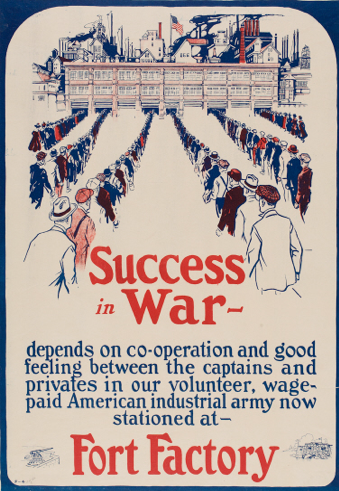
Gift of the Midwest Inter-Library Center, Chicago, Illinois. 1967.3.16
To meet the unprecedented wartime economic needs, the US government relied on a combination of voluntary and coercive measures. Leading the Food Administration, the famed mining engineer and humanitarian Herbert Hoover rejected rationing. He preferred to rely on high prices and a popular sense of patriotic duty to limit domestic consumption and assure adequate food supplies for the troops. As shown in the exhibit, many propaganda posters encouraged household efforts to conserve meat, wheat, and coal. The Food Administration called for wheatless Mondays, meatless Tuesdays, and porkless Saturdays, while the Fuel Administration asked for heatless Thursdays.
To pay for the war, the US government rejected simply printing more money and instead launched big public campaigns to sell savings stamps and bonds for the Liberty Loans. Nonetheless, the country experienced significant inflation because of the war, with the cost of living index rising by more than sixty percent between 1914 and 1918.
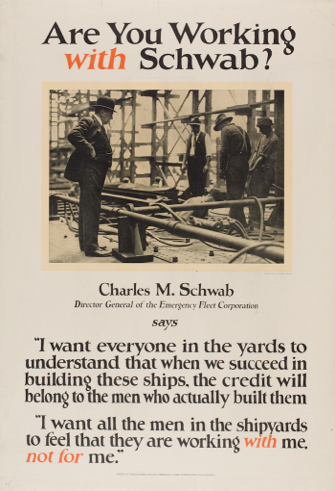
The Federal government continued some of the Progressive Era labor reforms and supported high wages and collective bargaining rights during the war. It also offered corporations financial incentives to support war production. The exhibit includes posters urging workers not to disrupt production by striking or changing jobs and in shipbuilding to support the efforts of the Emergency Fleet Corporation and its head, Charles M. Schwab, to produce new vessels as rapidly as possible.
Many of the wartime measures left an important legacy in the form of increased cooperation between government and industry during the 1920s.
